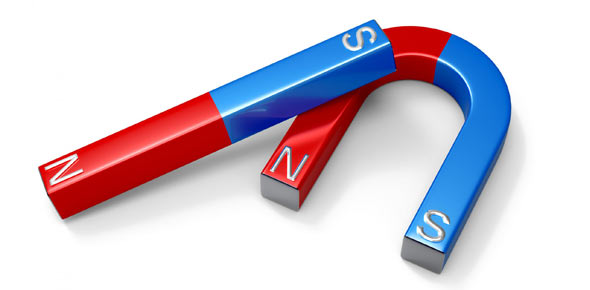Magnets And Magnetism Quiz

Questions about magnets and magnetism.
Questions and Answers
- 1.
When was the first compass invented?
- A.
A.D. 1087
- B.
A.D. 234
- C.
A.D.1033
Correct Answer
A. A.D. 1087Explanation
The first compass was invented in A.D. 1087.Rate this question:
-
- 2.
When two magnets have one force field, they are said to attract each other.
- A.
True
- B.
False
Correct Answer
A. TrueExplanation
When two magnets have one force field, it means that their magnetic fields are aligned in the same direction. This alignment causes the magnets to attract each other. The opposite poles of the magnets (north and south) attract each other, while the like poles (north and north, or south and south) repel each other. Therefore, when the magnets have the same force field, they attract each other.Rate this question:
-
- 3.
The bar magnet is stronger than the horseshoe magnet.
- A.
True
- B.
False
Correct Answer
B. FalseExplanation
The statement is false because the horseshoe magnet is actually stronger than the bar magnet. The horseshoe magnet has a U-shape, which allows for a stronger magnetic field to be concentrated at the ends of the U. This design makes the horseshoe magnet more efficient and stronger compared to the bar magnet, which has a weaker magnetic field that is spread out along its length. Therefore, the horseshoe magnet is considered to be stronger than the bar magnet.Rate this question:
-
- 4.
What magnet has a north and a south pole?
- A.
A plastic magnet
- B.
A polar magnet
- C.
A electronic magnet
- D.
None of the above
Correct Answer
B. A polar magnetExplanation
A polar magnet has a north and a south pole. Unlike a plastic magnet or an electronic magnet, which do not have distinct poles, a polar magnet has a clear magnetic field with opposite poles. Therefore, it is the only option among the given choices that fits the description of having both a north and a south pole.Rate this question:
-
- 5.
What are materials which lose their magnetism quickly?
- A.
Iron oxide materials
- B.
Expensive materials
- C.
"magnetically soft" materials
Correct Answer
C. "magnetically soft" materialsExplanation
"Magnetically soft" materials are substances that can easily lose their magnetism. These materials have low coercivity, meaning they require less external magnetic field to demagnetize. They are often used in applications where magnetism needs to be easily controlled or switched on and off, such as in transformers or electric motors. Iron oxide materials, on the other hand, are not specifically known for losing magnetism quickly, and expensive materials do not necessarily have any correlation with their magnetic properties.Rate this question:
-
- 6.
Temporary magnets become magnetized for a short period of time by what?
- A.
Magnetite
- B.
Induction
- C.
Metal
Correct Answer
B. InductionExplanation
Temporary magnets become magnetized for a short period of time through induction. Induction occurs when a magnetic field is created in a material, such as a metal, by bringing it close to a permanent magnet. This causes the alignment of magnetic domains within the material, resulting in temporary magnetization. Once the magnet is removed, the material loses its magnetism. Magnetite is a naturally occurring magnetic mineral, but it is not directly related to the process of induction in temporary magnets.Rate this question:
-
- 7.
A bar of iron placed across the ends of a horseshoe magnet to help preserve the magnetism is called a "___________."
Correct Answer
keeperExplanation
A bar of iron placed across the ends of a horseshoe magnet is called a "keeper". This is because it helps preserve the magnetism of the horseshoe magnet by creating a closed magnetic circuit. The keeper acts as a magnetic pathway, preventing the magnetic field from leaking out and keeping the magnetism strong. Without a keeper, the horseshoe magnet could gradually lose its magnetism over time.Rate this question:
Quiz Review Timeline +
Our quizzes are rigorously reviewed, monitored and continuously updated by our expert board to maintain accuracy, relevance, and timeliness.
-
Current Version
-
Mar 21, 2023Quiz Edited by
ProProfs Editorial Team -
Mar 11, 2011Quiz Created by
11Michelle11
- Acceleration Quizzes
- Acoustic Quizzes
- Chapters Of Physics Quizzes
- Distance Quizzes
- Electrolysis Quizzes
- Energy Quizzes
- ESD Quizzes
- Frequency Quizzes
- Light And Reflection Quizzes
- Logic Gate Quizzes
- Momentum Quizzes
- Motion Quizzes
- Online Physics Quizzes
- Optics Quizzes
- Physics Of Sound Quizzes
- Practice Physics Quizzes
- Properties Of Matter Quizzes
- Quantum Quizzes
- Quantum Physics Quizzes
- Reflection Quizzes
- Refraction Quizzes
- Secondary 3 Physics Quizzes
- Sound Quizzes
- Speed Of Light Quizzes
- Thermodynamics Quizzes
- Velocity Quizzes
- Work And Energy Quizzes
 Back to top
Back to top


